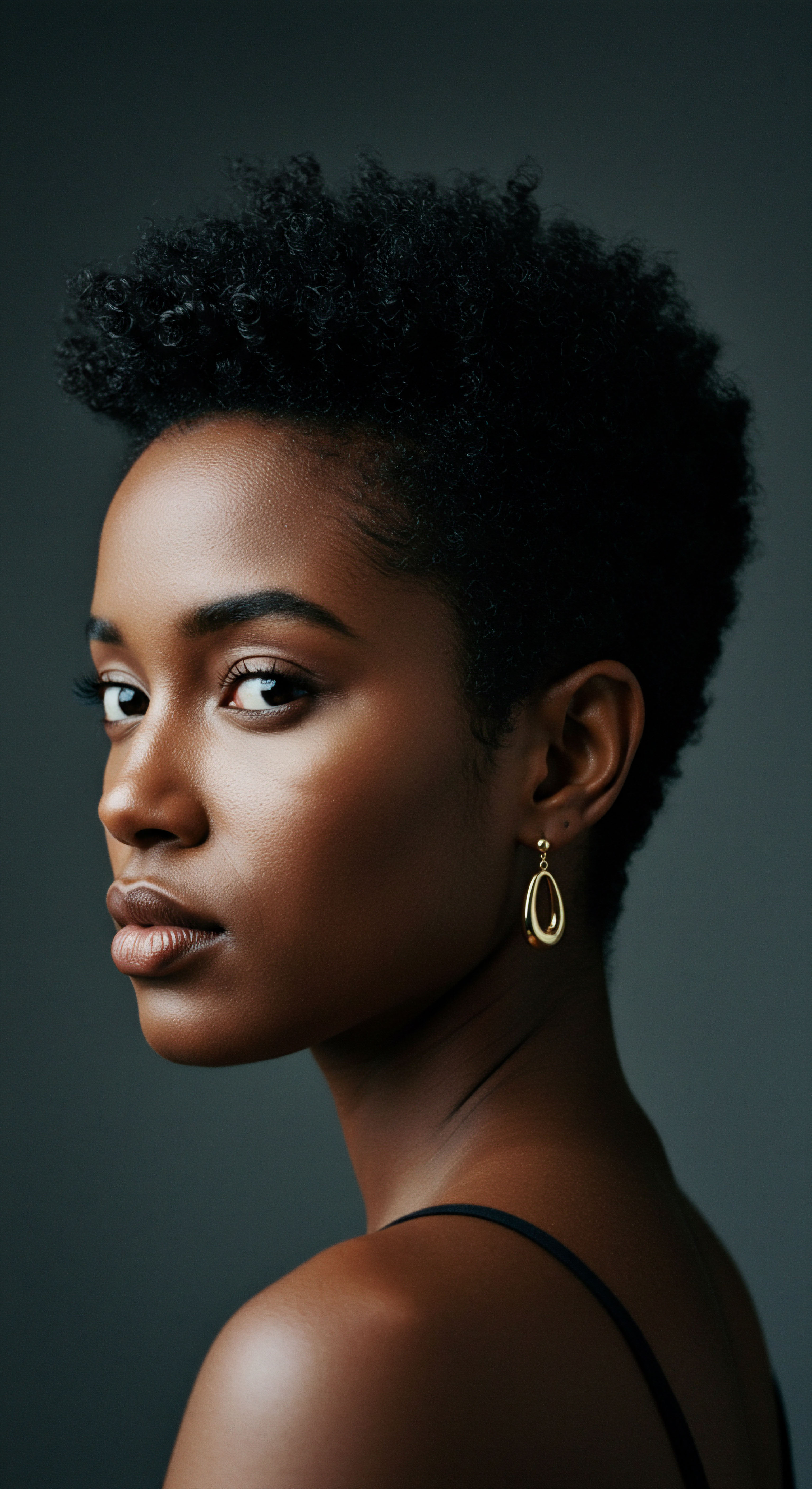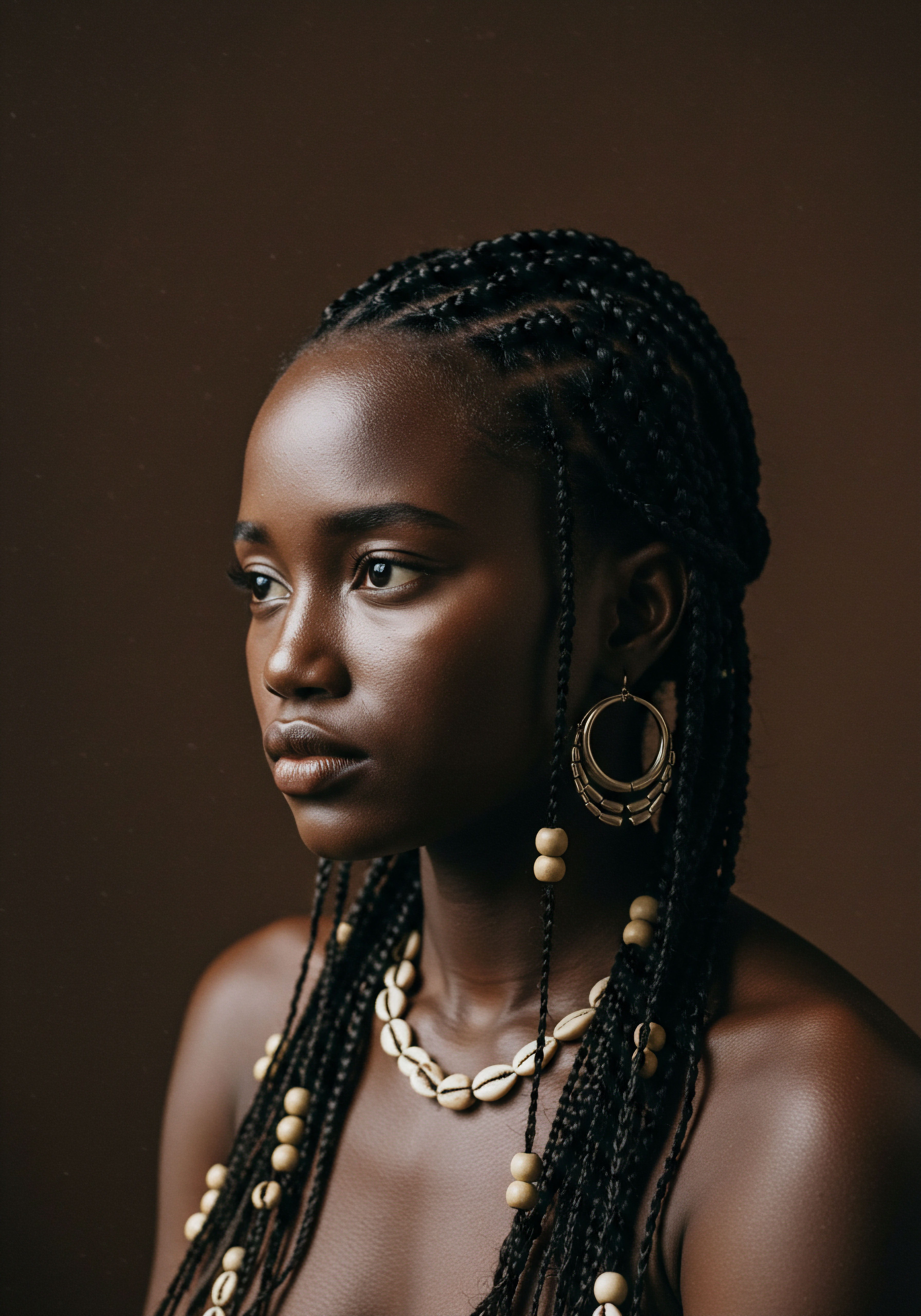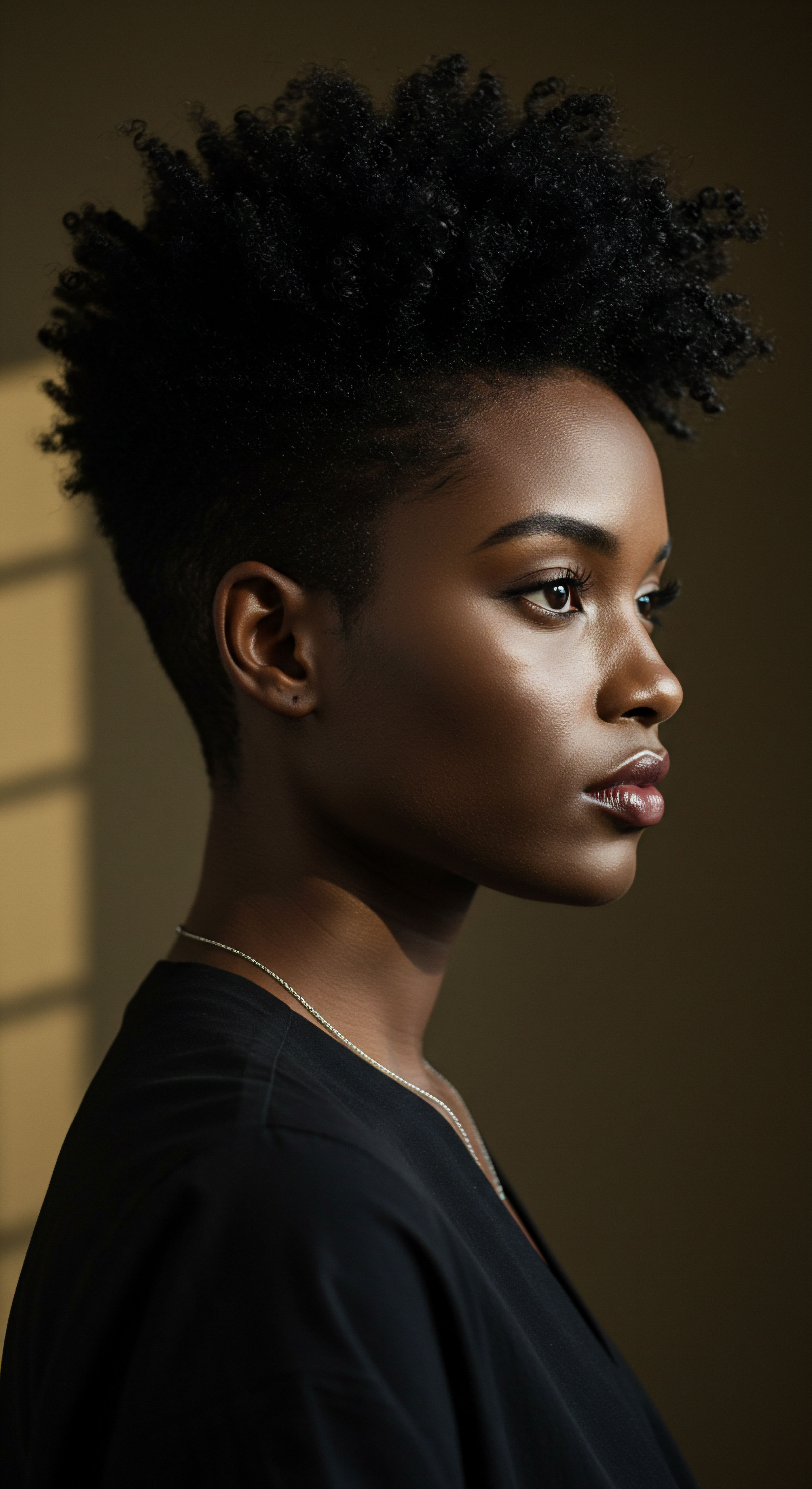
Roots
The skin that cradles our hair, the scalp, often whispers its needs in subtle ways, sometimes through a gentle tingle, at other times with a quiet tightness. For those with textured hair, this living landscape presents its own unique set of considerations, a rich terrain of coils, curls, and waves. Understanding the fundamental nature of this skin, its delicate balance, forms the very groundwork of authentic care. It is here, at this essential foundation, that we begin to consider the curious case of topical melatonin and its interaction with scalp hydration.
Melatonin, a molecule celebrated for orchestrating our body’s internal rhythms, holds a surprising connection to the skin and hair. Beyond its familiar role in regulating sleep cycles, this biological messenger extends its influence to various peripheral tissues, including the very surface that supports our strands. The skin, a remarkable organ, possesses its own capacity to produce and respond to melatonin, housing specific receptors that await its signal. This localized system suggests a deeper, more intricate relationship than often perceived, hinting at melatonin’s part in maintaining skin equilibrium.
The moisture balance of the scalp, particularly for textured hair, stands as a cornerstone of its vitality. Coiled and curly strands, by their very architecture, present a greater challenge for natural oils, known as sebum, to travel from the scalp down the hair shaft. This inherent structural characteristic can predispose textured hair to a greater propensity for dryness compared to straighter hair types. A well-hydrated scalp feels supple, allowing hair to grow from a healthy base, while a compromised moisture barrier can lead to discomfort and diminished hair appearance.

What Sustains Scalp Hydration?
Maintaining a healthy scalp environment relies on a symphony of internal and external elements. The sebaceous glands, tiny producers nestled within the skin, release sebum, a natural lipid blend that lubricates the scalp and hair. This protective layer acts as a shield, helping to seal in moisture and defend against environmental stressors. When this natural production falters, or when external factors disrupt the delicate balance, the scalp can signal its distress through dryness, flaking, or a persistent sensation of tightness.
The body’s overall hydration, nutritional intake, and even stress levels play a silent, yet significant, part in the scalp’s condition. Just as a garden thirsts for water, so too does the skin require consistent internal moisture to flourish. Similarly, certain dietary components, such as essential fatty acids, contribute to the integrity of skin barriers.
The scalp, a vital foundation for healthy hair, maintains its well-being through a delicate balance of natural oils and internal hydration.
Melatonin’s presence in the scalp is not a mere coincidence. Hair follicles themselves possess melatonin receptors, acting as cellular antennae receptive to its presence. This cellular dialogue implies melatonin’s capacity to influence hair growth cycles and potentially the surrounding skin environment.
While its primary association is with stimulating hair growth and density, particularly for conditions like androgenetic alopecia, its broader dermatological actions include antioxidant and anti-inflammatory properties, which generally support skin health. The question then arises ❉ how might a substance celebrated for its protective qualities, when applied topically, intersect with the intricate dynamics of scalp moisture, especially for hair textures already predisposed to a drier nature?
Consider the cellular mechanisms at play. Melatonin can influence cellular activity within the skin, including keratinocytes, which are crucial for skin barrier function. A healthy skin barrier is paramount for preventing transepidermal water loss, a key contributor to dryness. If melatonin were to disrupt this delicate balance, even subtly, it could manifest as a sensation of dryness.

Ritual
The path to understanding our scalp’s practical needs often begins with the rhythms of daily care, those cherished practices passed down through generations or discovered through personal exploration. For textured hair, these rituals are more than routine; they are acts of nurturing, often designed to counteract an inherent inclination towards dryness. We apply oils, conditioners, and specialized elixirs, each chosen with the quiet hope of bringing balance and vitality to the scalp. Into this landscape of intentional care, the introduction of topical melatonin products prompts a thoughtful inquiry into their tangible effects.
When considering the application of topical melatonin, one might anticipate only its widely reported benefits for hair growth and density. Indeed, studies have shown that it can prolong the anagen, or growth, phase of hair, leading to thicker, more robust strands. Its antioxidant capabilities offer a protective shield to hair follicles, safeguarding them from environmental stressors that might otherwise impede healthy growth. Yet, even in this generally positive context, the skin’s individual response can present unexpected variations.

How Might Topical Melatonin Interact with Scalp Moisture?
A direct interaction between topical melatonin and scalp dryness is sometimes reported as a mild, temporary side effect. Individuals using topical melatonin solutions have occasionally noted sensations of skin reddening, increased sensitivity, a slight burning, or itching. More specifically, some product information and clinical observations mention dryness as a potential, albeit usually transient, experience when commencing treatment.
The presence of certain ingredients within topical formulations might contribute to this perceived dryness. For instance, some melatonin solutions may contain substances like propylene glycol, which, for some individuals, can be an irritant or have a drying effect on the skin. It becomes a consideration not only of the active compound, melatonin, but also of the vehicle carrying it to the scalp.
Topical melatonin, while celebrated for hair growth, may occasionally prompt temporary scalp dryness, a response often linked to individual skin sensitivity or product formulation.
The experience of scalp dryness can be influenced by numerous factors, making it a complex sensation to attribute to a single cause. For those with textured hair, a naturally drier scalp environment is a common reality, due to the structure of the hair itself, which can impede the even distribution of sebum. This inherent predisposition means that even a slight shift in the scalp’s hydration equilibrium could be more readily perceived.

What Can Influence Individual Scalp Responses?
- Underlying Scalp Conditions ❉ Individuals with pre-existing scalp concerns such as eczema, psoriasis, or contact dermatitis may find their skin more reactive to new topical applications.
- Product Formulation ❉ The full ingredient list of a topical melatonin product matters. Alcohol content, preservatives, or other active ingredients can impact scalp moisture.
- Application Frequency and Quantity ❉ Over-application or too frequent use might overwhelm the scalp’s natural defenses, leading to irritation or a sensation of dryness.
In many instances, if dryness or irritation does surface, it is often described as mild and temporary, resolving as the scalp adjusts to the new product or with minor adjustments to the application routine. This suggests that for most, the scalp finds its equilibrium, integrating the new element into its existing rhythms.
The wisdom of our ancestors, particularly within textured hair traditions, has long centered on maintaining scalp suppleness. Practices like scalp oiling, a ritual found in Ayurvedic medicine and African haircare traditions, aim to replenish moisture and soothe the skin. These age-old methods underscore the universal recognition of the scalp as a living entity deserving of gentle, consistent care. When introducing modern compounds like topical melatonin, a similar mindfulness can guide our approach, observing the scalp’s unique response and adapting our rituals accordingly.

Relay
Stepping beyond the immediate observations of topical application, we delve into the deeper scientific conversations surrounding melatonin’s interaction with the scalp, a dialogue where cellular biology meets individual experience. The question of whether topical melatonin can cause scalp dryness prompts an exploration of the body’s subtle chemistries, the nuanced responses of the skin, and the complex interplay of internal and external factors that shape our scalp’s hydration. This deeper consideration requires us to move past simplistic answers, seeking a more profound understanding of the mechanisms at play.
Melatonin, a hormone renowned for its rhythmic signaling, possesses a remarkable ability to interact with various cellular components within the skin. Its receptors, MT1 and MT2, are not only present in the hair follicles but also in keratinocytes and fibroblasts, cells fundamental to the skin’s barrier function and structural integrity. This direct cellular communication suggests that melatonin can influence the skin’s ability to retain water and maintain its protective shield. Indeed, studies have shown that melatonin can enhance skin barrier function by stimulating keratin expression, a process vital for preventing moisture loss.
The paradox then surfaces ❉ if melatonin generally supports skin barrier health, why might some individuals experience dryness? One line of reasoning involves the delicate balance of sebaceous gland regulation. Melatonin has been observed to influence these glands, potentially helping to regulate excess oil production.
While this is often cited as a benefit for those with oily scalps, an overzealous regulation in individuals already predisposed to lower sebum production, such as many with textured hair, could theoretically tip the balance towards dryness. This hypothetical scenario highlights the complexity of biological responses, where a beneficial action in one context might present a challenge in another.

Can Melatonin’s Hormonal Influence Shift Scalp Balance?
The skin, including the scalp, is a neuroendocrine organ, meaning it produces and responds to hormones. Hormonal fluctuations, such as the decline in estrogen during menopause, are well-documented contributors to overall skin and scalp dryness due to reduced sebum production. While topical melatonin primarily acts locally, the broader hormonal landscape of the individual could influence how their scalp responds to any new compound.
Consider the compelling, if perhaps unsettling, observation from a case report involving oral melatonin use. A 2022 report detailed a case of Facial Acne appearing in a patient using oral melatonin, an unexpected dermatological effect given melatonin’s generally protective skin profile. This particular instance, while concerning systemic melatonin and not topical scalp dryness directly, illuminates the complex and sometimes unpredictable ways melatonin can interact with the body’s hormonal systems and skin physiology. The report suggested a potential mechanism involving melatonin’s influence on prolactin (PRL) release, which can affect sebum production and skin conditions.
This example underscores that even a substance known for its benefits can, in specific individuals, trigger responses that deviate from the expected, pushing the skin’s delicate balance in surprising directions. It invites us to consider that even a localized application on the scalp might, in rare cases, participate in a wider physiological conversation, subtly altering the scalp’s equilibrium.
Melatonin’s nuanced interaction with the scalp’s intricate biological systems suggests that while generally supportive, individual responses to topical application can vary.
The interplay of factors that lead to scalp dryness extends beyond direct chemical interaction. Environmental conditions, the frequency and type of cleansing products used, and even genetic predispositions contribute to the scalp’s moisture levels. For textured hair, the unique helical shape of the hair strand itself makes it inherently more challenging for naturally produced oils to coat the entire length, leaving the scalp and hair more vulnerable to moisture loss.
Therefore, when dryness is experienced with topical melatonin, it might not be a direct drying action, but rather an interaction with an already sensitive or predisposed scalp, or perhaps a consequence of other ingredients within the product. The mild, temporary nature of such dryness, as noted in several studies, suggests that the scalp often adapts, or that the discomfort is not severe enough to disrupt the overall beneficial effects on hair growth.

Understanding Scalp Responses
To truly grasp the individual experience, a holistic view becomes paramount. This involves:
- Personal History ❉ An individual’s prior scalp conditions, sensitivities, and responses to other topical products.
- Product Composition ❉ A thorough examination of the entire ingredient list, not just the active component, for potential irritants.
- Observational Acuity ❉ A careful, gentle awareness of the scalp’s signals, allowing for adjustments in routine or product choice.
The science continues to paint a picture of melatonin as a beneficial agent for hair and skin health, primarily through its antioxidant and cell-regulating properties. Yet, the human body, in its wondrous complexity, always retains an element of individual variability. This invites a gentle curiosity, prompting us to approach topical treatments with an open mind, ready to observe and adapt, honoring the unique story of each scalp.
| Factor Hair Structure |
| Influence on Scalp Moisture Coiled hair impedes sebum distribution from scalp to ends, leading to inherent dryness. |
| Factor Cleansing Habits |
| Influence on Scalp Moisture Over-washing or use of harsh, sulfate-laden shampoos can strip natural oils. |
| Factor Hormonal Shifts |
| Influence on Scalp Moisture Declining estrogen (e.g. during menopause) reduces sebum production, causing dryness. |
| Factor Environmental Conditions |
| Influence on Scalp Moisture Cold, dry climates and indoor heating reduce atmospheric moisture, impacting scalp hydration. |
| Factor Product Ingredients |
| Influence on Scalp Moisture Certain components in hair products, beyond the active ingredient, can cause irritation or dryness. |
| Factor These factors collectively shape the scalp's hydration, particularly for those with textured hair. |

Reflection
Our journey through the landscape of topical melatonin and scalp dryness reveals a story less about a simple cause-and-effect and more about a delicate dance of biological systems, individual sensitivities, and the profound impact of our daily rituals. The scalp, far from a passive foundation, emerges as a responsive ecosystem, constantly adjusting to internal whispers and external influences. While some individuals may indeed experience a temporary sensation of dryness when introducing topical melatonin, this appears to be a minor, often transient, note in the broader symphony of its benefits for hair vitality. The wisdom lies not in rigid adherence to universal rules, but in cultivating a deep, listening connection with our own unique scalp, understanding its subtle language, and tending to its needs with informed gentleness.

References
- Babadjouni, A. Reddy, M. Zhang, R. et al. (2023). Melatonin and the Human Hair Follicle. Journal of Drugs in Dermatology, 22(3), 260-264.
- Fischer, T. W. Trüeb, R. M. Hänggi, D. et al. (2012). Topical Melatonin for Treatment of Androgenetic Alopecia. International Journal of Trichology, 4(1), 23-28.
- Koreck, A. Kemeny, L. & Csati, S. (2022). Effect of Melatonin on Psoriatic Phenotype in Human Reconstructed Skin Model. MDPI, 11(3), 395.
- Mauriz, J. L. et al. (2018). Assessing the Potential Role for Topical Melatonin in an Antiaging Skin Regimen. Journal of Drugs in Dermatology, 17(9), 966-970.
- Milani, M. & Fischer, T. W. (2018). Melatonin and hair physiology ❉ reasons and clinical efficacy data as a topical treatment of androgenic alopecia. Medigraphic, 20(1), 30-36.
- Ozyurt, K. Baykal, C. & Demir, S. (2022). Melatonin Related Acneiform Lesions ❉ A Case Report and Potential Mechanism. Journal of Clinical and Analytical Medicine, 13(1), 116-118.
- Sae-Lim, P. et al. (2024). Protective Effects of Melatonin on the Skin ❉ Future Perspectives. MDPI, 13(5), 1121.
- Vázquez, J. et al. (2023). Melatonin improves skin barrier damage caused by sleep restriction through gut microbiota. Experimental Dermatology, 32(9), 1547-1558.
- Wang, L. et al. (2018). Melatonin Promotes Cashmere Goat (Capra Hircus) Secondary Hair Follicle Growth ❉ A View from Integrated Analysis of Long Non-Coding and Coding RNAs. Cell Cycle, 17(11), 1255-1267.
- Wong, R. L. et al. (2016). Effect of topical application of melatonin cream 12.5% on cognitive parameters ❉ A randomized, placebo-controlled, double-blind crossover study in healthy volunteers. Journal of Pineal Research, 61(2), 254-261.